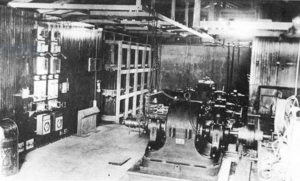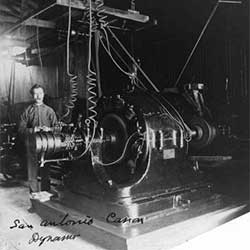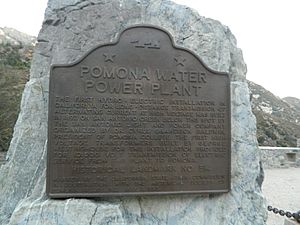Pomona Water Powerplant facts for kids
Quick facts for kids Pomona Water Power Plant |
|
|---|---|

The Pomona Water Powerplant, c. 1892
|
|
| Location | San Antonio Canyon, California |
| Built | 1892 |
| Designated | Nov. 25, 1953 |
| Reference no. | 514 |
| Lua error in Module:Location_map at line 420: attempt to index field 'wikibase' (a nil value). | |
The Pomona Water Power Plant was a very important building built in 1892. It was the first power plant in California to use something called AC electricity. This plant sent power to the Pomona Valley. It was named a California Historic Landmark (No. 514) on November 25, 1953.
Contents
What Was the Pomona Power Plant?
The Pomona Water Power Plant was built by the San Antonio Light and Power Company. You can find it near Mount Baldy Village in Los Angeles County. It sits on Camp Baldy Road, right in San Antonio Canyon.
This power plant used hydroelectric power. This means it made electricity from moving water. It used alternating current (AC) to send power over long distances. The plant could send electricity at very high voltages.
How Did It Work?
The San Antonio Creek was the main power source for the plant. Its water turned a special machine called a dynamo or alternator. This machine created the electricity.
This system was different from what Thomas Edison used. Edison's system could not send power very far. The Pomona plant's AC system was much better for long-distance power.
Who Built It?
The idea for the San Antonio Light and Power Company came from Dr. Cyrus Grandison Baldwin. He was the first president of Pomona College. Dr. Baldwin worked with a businessman named Henry Harbison Sinclair.
They hired A.W. Decker to be the chief engineer. Decker knew a lot about AC power. He had also worked on the Mount Lowe Railway near Pasadena.
Sending Power Far Away
Westinghouse Electric Corporation built the special high-voltage transformers for the plant. These transformers increased the power to 10,000 volts. This high voltage allowed the electricity to travel 14 miles to the city of Pomona.
The system started on November 28, 1892. It worked so well that a 29-mile line was added. This new line sent power all the way to San Bernardino, California. This was a world record for sending electricity over such a long distance!
Why It Didn't Last
The Pomona Water Power Plant worked great at first. However, Southern California doesn't always get enough rain or snow. The plant relied on this water. There was no good place to build a dam to store water for dry times. Because of this, the plant was not as successful in later years.
A.W. Decker's next project was at the Mill Creek plant. There, he used a new system called three-phase power. This system was even more efficient. It began working on September 7, 1893.
Historic Marker
There is a special marker at the site of the plant. It tells visitors about its history. The marker says:
- NO. 514 POMONA WATER POWERPLANT – The first hydroelectric installation in California for long-distance transmission of alternating current at high voltage was built in 1892 on San Antonio Creek below this spot by the San Antonio Light and Power Company organized by Dr. Cyrus Grandison Baldwin, President of Pomona College. The first high-voltage transformers built by George Westinghouse for this installation provided for transmission of 10,000 volts from the plant to Pomona.



